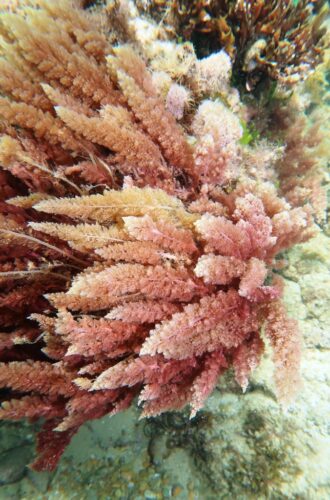There has been a new development since I wrote my two articles about red alga use in agriculture –
Update re Red Alga Use in Agriculture
The SA State Government made a major announcement in January 2022. Details were posted to the PIRA/SARDI website.
According to Seaweed industry to continue to grow in SA dated Wednesday 5 January 2022: –
“A new global seaweed hub has officially been launched in Adelaide in another major step towards commercialising seaweed production in South Australia, which could lead to a $140 million new industry within three years and potentially support up to 1,200 local jobs.
International company CH4 has set up a Market Development Hub at the South Australian Aquatic Sciences Centre, in West Beach.
The Market Development Hub in Adelaide is a world-first, enabling CH4 to grow, test, analyse, process and manufacture commercial grade seaweed products which will be exported to potential buyers in Australia and internationally.

Red seaweed (Asparagopsis armata and A. taxiformis) can be used in industries such as pharmaceuticals, cosmetics, food production, animal and stock feed and it is expected to play a major part in the global effort to reduce methane emissions.
When used in livestock feed rations, red seaweed could reduce methane emissions from cattle and sheep by up to 90 per cent.
Minister for Environment and Water David Speirs joined CH4 Global’s Chief Executive Officer Steve Meller and Australian General Manager Adam Main, for a tour of the research facility.
“Seaweed may not seem like a valuable resource to some, but this is a huge opportunity for South Australia to be first to market and become a world leader in an industry which could add more than $100 million to the state economy and create hundreds of local jobs,” Minister Speirs said.
“The seaweed market has a diverse range of uses such as pharmaceuticals, sustainable food source for humans, nutraceuticals, cosmetics, eco-friendly bio-plastics and biopolymers, fertilizer, as well as livestock and aquafeeds.
“This work could be a game-changer for the environment and continue South Australia’s leadership in taking action against climate change.”
Minister for Primary Industries and Regional Development David Basham said the Marshall Liberal Government is investing more than $2 million to help establish South Australia as an international leader in commercial seaweed.
“South Australia is uniquely positioned to take advantage of the growing international interest in this sector with a highly desirable environment to grow seaweed as well as an international reputation for high quality seafood and state-of-the-art research and development capability,” Minister Basham said.
“Over the next two years we are looking to foster the engagement between commercial industry companies, technical experts and researchers in order to enhance the understanding of seaweed as a raw material along with identifying and resolving constraints that currently exist to large scale seaweed production.”
“For the livestock industries this product has potential for win-win outcomes with enhanced conversion of feed to extra growth and milk production, as well as reducing ruminant methane emissions.”
CH4 Global Chief Executive Officer Dr Steve Meller, who grew up in South Australia and now lives in Silicon Valley, said he was excited for the potential for this project to give back to South Australia.
“South Australia is perfectly placed to be a base for this burgeoning new asparagopsis industry. The launch of the CH4 market development facility in Adelaide will accelerate this process. We are hugely excited for the year ahead,” Dr Meller said.
CH4’s Australia GM, Adam Main, also highlighted the importance of the new site, saying:
“The processing room here at SARDI is the final step on the road to market development. As seen earlier this year with our first test export to Korea, we are now able to produce commercial grade product for testing by potential buyers – a major milestone before we move towards large-scale production. 2022 will be a hugely exciting year here at SARDI while we also look to finalise the location of our manufacturing facility on the Eyre Peninsula.”
The SARDI facility is already operational and will scale-up further through 2022 while the company also identifies a location and begins construction of a commercial scale processing facility on the Eyre Peninsula. In November, CH4 exported its first test material from Adelaide to a major potential buyer in South Korea and this process will now be scaled significantly to all continents.”


Its my simplistic belief that,when the potentially huge markets and the ecological and climate change mitigation benefits of this whole Asparagopsis thing are considered, the $$ amounts(currently in the 100s of millions) being bandied about by key players in the R&D and political sectors are very conservative.
I’d expect that within a year or two the same heads will be talking $billions, and within a decade $100s of billions.
(Declaration of interest: I’m not financially involved in any Asparagopsis projects and have no financial qualifications. My fascination with this topic rests on the spectacular win-win benefits for sustainable management of global climate change, which equates with the desperately urgent need to maintain biodiversity and drastically reduce extinction rates across all levels of life,terrestrial and aquatic).